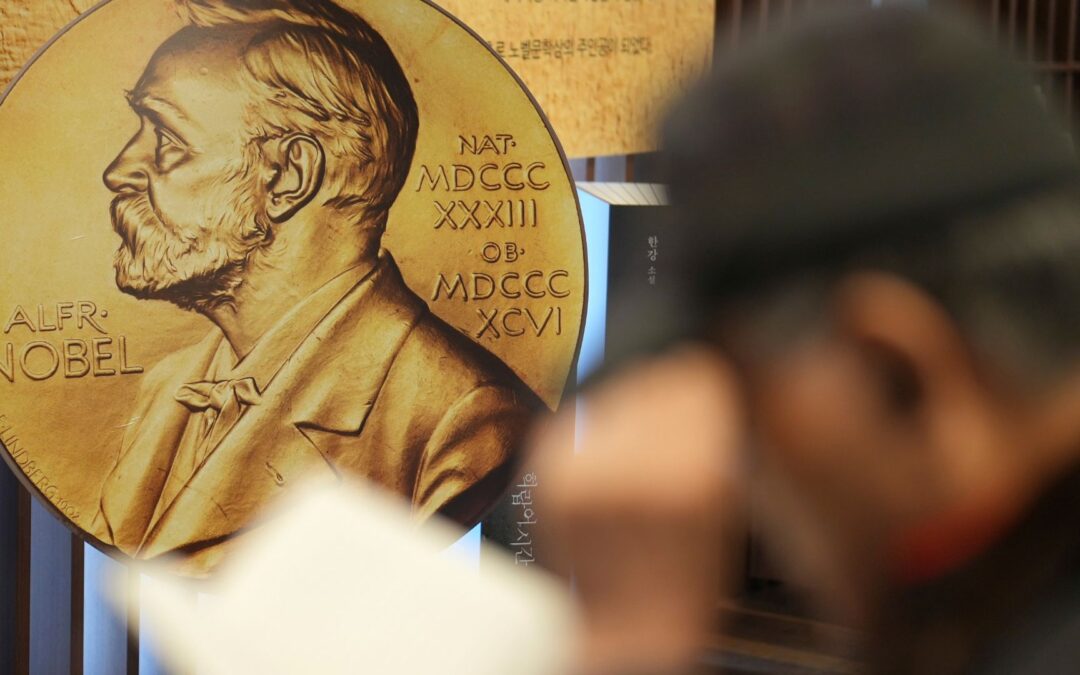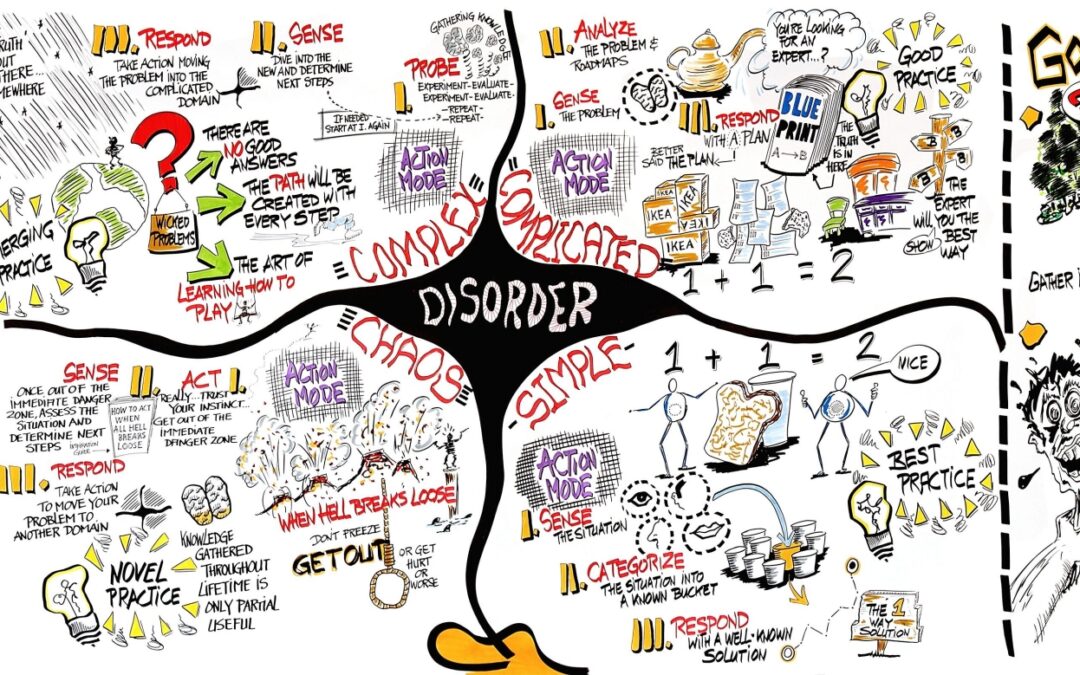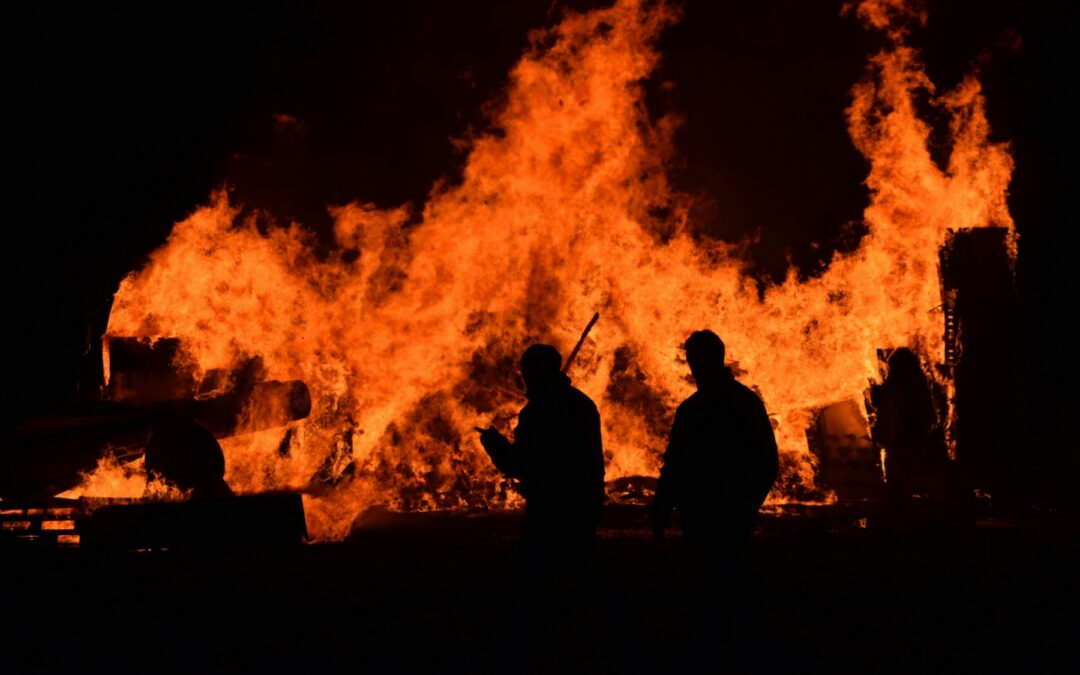
by Robyn Bolton | Oct 13, 2025 | Innovation, Leading Through Uncertainty
As a kid, you’re taught that when you’re lost, stay put and wait for rescue. Most executives are following that advice right now—sitting tight amid uncertainty, hoping someone saves them from having to make hard choices and take innovation risk.
This year’s Nobel Prize winners in Economics have bad news: there is no rescue coming. Joel Mokyr, Philippe Aghion, and Peter Howitt demonstrated that disruption happens whether you participate or not. Freezing innovation investments doesn’t reduce innovation risk. It guarantees competitors destroy you while you stand still.
They also have good news: innovation follows predictable patterns based on competitive dynamics, offering a framework for making smarter investment decisions.
How We Turned Stagnation into a System for Growth
For 99.9% of human history, economic growth was essentially zero. There were occasional bursts of innovation, like the printing press, windmills, and mechanical clocks, but growth always stopped.
200 years ago, that changed. Mokyr identified that the Industrial Revolution created systems connecting two types of knowledge: Propositional knowledge (understanding why things work) and Prescriptive knowledge (practical instructions for how to execute).
Before the Industrial Revolution, these existed separately. Philosophers theorized. Artisans tinkered. Neither could build on the other’s work. But the Enlightenment created feedback loops between theory and practice allowing countries like Britain to thrive because they had people who could translate theory into commercial products.
Innovation became a system, not an accident.
Why We Need Creative Destruction
Every year in the US, 10% of companies go out of business and nearly as many are created. This phenomenon of creative destruction, where companies and jobs constantly disappear and are replaced, was identified in 1942. Fifty years later, Aghion and Howitt built a mathematical model proving its required for growth.
Their research also lays bare some hard truths:
- Creative destruction is constant and unavoidable. Cutting your innovation budget does not pause the game. It forfeits your position. Competitors are investing in R&D right now and their innovations will disrupt yours whether you participate or not.
- Competitive position predicts innovation investments. Neck-to-neck competitors invest heavily in innovation because it’s their only path to the top. Market leaders cut back and coast while laggards don’t have the funds to catch-up. Both under-invest and lose.
- Innovation creates winners and losers. Creative destruction leads to job destruction as work shifts from old products and skills to new ones. You can’t innovate and protect every job but you can (and should) help the people affected.
Ultimately, creative destruction drives sustained growth. It is painful and scary, but without it, economies and society stagnate. Ignore it at your peril. Work with it and prosper.
From Prize-winning to Revenue-generating
Even though you’re not collecting the one million Euro prize, these insights can still boost your bottom line if you:
- Connect your Why teams with your How teams. Too often, Why teams like Strategy, Innovation, and R&D, chuck the ball over the wall to the How teams in Operations, Sales, Supply Chain, and front-line operations. Instead, connect them early and often and ensure the feedback loop that drives growth
- Check your R&D and innovation investments. Are your R&D and innovation investments consistent with your strategic priorities or your competitive position? What are your investments communicating to your competitors? It’s likely that that “conserving cash” is actually coasting and ceding share.
- Invest in your people and be honest with them. Your employees aren’t dumb. They know that new technologies are going to change and eliminate jobs. Pretending that won’t happen destroys trust and creates resistance that kills innovation. Tell employees the truth early, then support them generously through transitions.
What’s Your Choice?
Playing it safe guarantees the historical default: stagnation. The 2025 Nobel Prize winners proved sustained growth requires building innovation systems and embracing creative destruction.
The only question is whether you will participate or stagnate.

by Robyn Bolton | Sep 30, 2025 | Leading Through Uncertainty, Strategy, Tips, Tricks, & Tools
Just as we got used to VUCA (volatile, uncertain, complex, ambiguous) futurists now claim “the world is BANI now.” BANI (brittle, anxious, nonlinear, incomprehensible) is much worse than VUCA and reflects “the fractured, unpredictable state of the modern world.”
Not to get too Gen X on the futurists who coined and are spreading this term but…shut up.
Is the world fractured and unpredictable? Yes.
Does it feel brittle? Are we more anxious than ever? Are things changing at exponential speed, requiring nonlinear responses? Does the world feel incomprehensible? Yes, to all.
Naming a problem is the first step in solving it. The second step is falling in love with the problem so that we become laser focused on solving it. BANI does the first but fails at the second. It wallows in the problem without proposing a path forward. And as the sign says, “Ain’t nobody got time for this.”
(Re)Introducing the Cynefin Framework
The Cynefin framework recognizes that leadership and problem-solving must be contextual to be effective. Using the Welsh word for “habitat,” the framework is a tool to understand and name the context of a situation and identify the approaches best suited for managing or solving the situation.
It’s grounded in the idea that every context – situation, challenge, problem, opportunity – exists somewhere on a spectrum between Ordered and Unordered. At the Ordered end of the spectrum, cause and affect are obvious and immediate and the path forward is based on objective, immutable facts. Unordered contexts, however, have no obvious or immediate relationship between cause and effect and moving forward requires people to recognize patterns as they emerge.
Both VUCA and BANI point out the obvious – we’re spending more time on the Unordered end of the spectrum than ever. Unlike the acronyms, Cynefin helps leaders decide and act.
5 Contexts. 5 Ways Forward
The Cynefin framework identifies five contexts, each with its own best practices for making decisions and progress.
On the Ordered end of the spectrum:
- Simple contexts are characterized by stability and obvious and undisputed right answers. Here, patterns repeat, and events are consistent. This is where leaders rely on best practices to inform decisions and delegation, and direct communication to move their teams forward.
- Complicated contexts have many possible right answers and the relationship between cause and effect isn’t known but can be discovered. Here, leaders need to rely on diverse expertise and be particularly attuned to conflicting advice and novel ideas to avoid making decisions based on outdated experience.
On the Unordered end of the spectrum:
- Complex contexts are filled with unknown unknowns, many competing ideas, and unpredictable cause and effects. The most effective leadership approach in this context is one that is deeply uncomfortable for most leaders but familiar to innovators – letting patterns emerge. Using small-scale experiments and high levels of collaboration, diversity, and dissent, leaders can accelerate pattern-recognition and place smart bets.
- Chaos are contexts fraught with tension. There are no right answers or clear cause and effect. There are too many decisions to make and not enough time. Here, leaders often freeze or make big bold decisions. Neither is wise. Instead, leaders need to think like emergency responders and rapidly response to re-establish order where possible to bring the situation into a Complex state, rather than trying to solve everything at once.
The final context is Disorder. Here leaders argue, multiple perspectives fight for dominance, and the organization is divided into fractions. Resolution requires breaking the context down into smaller parts that fit one of the four previous contexts and addressing them accordingly.
The Only Way Out is Through
Our VUCA/BANI world isn’t going to get any simpler or easier. And fighting it, freezing, or fleeing isn’t going to solve anything. Organizations need leaders with the courage to move forward and the wisdom and flexibility to do so in a way that is contextually appropriate. Cynefin is their map.

by Robyn Bolton | Sep 16, 2025 | Leading Through Uncertainty, Tips, Tricks, & Tools
When a project is stuck and your team is trying to manage uncertainty, what do you hear most often:
- “We’re so afraid of making the wrong decision that we don’t make any decisions.”
- “We don’t have time to explore a bunch of stuff. We need to make decisions and go.”
- “The problem is so multi-faceted, and everything affects everything else that we don’t know where to start.”
I’ve heard all three this week, each spoken by teams leads who cared deeply about their projects and teams.
Differentiating between risk and uncertainty and accepting that uncertainty would never go away, just change focus helped relieve their overwhelm and self-doubt.
But without a way to resolve the fear, time-pressure, and complexity, the project would stay stuck with little change of progressing to success.
Turn uncertainty into an asset
It’s a truism in the field of innovation that you must fall in love with the problem, not the solution. Falling in love with the problem ensures that you remain focused on creating value and agnostic about the solution.
While this sounds great and logically makes sense, most struggle to do it. As a result, it takes incredible strength and leadership to wrestle with the problem long enough to find a solution.
Uncertainty requires the same strength and leadership because the only way out of it is through it. And, research shows, the process of getting through it, turns it into an asset.
3 Steps to turn uncertainty into an asset
Research in the music and pharmaceutical industries reveals that teams that embraced uncertainty engaged in three specific practices:
- Embrace It: Start by acknowledging the uncertainty and that things will change, go wrong, and maybe even fail. Then stay open to surprise and unpredictability, delving into the unknown “by being playful, explorative, and purposefully engaging in ventures with indeterminate outcome.”
- Fix It: Especially when dealing with Unknowable Uncertainty, which occurs when more info supports several different meanings rather than pointing to one conclusion, teams that succeed make provisional decisions to “fix” an uncertain dimension so they can move forward while also documenting the rationale for the fix, setting a date to revisit it, and criteria for changing it.
- Ignore It: It’s impossible to embrace every uncertainty at once and unwise to fix too many uncertainties at the same time. As a result, some uncertainties, you just need to ignore. Successful teams adopt “strategic ignorance” “not primarily for purposes of avoiding responsibility [but to] allow postponing decisions until better ideas emerge during the collaborative process.
This practice is iterative, often leading to new knowledge, re-examined fixes, and fresh uncertainties. It sounds overwhelming but the teams that are explicit and intentional about what they’re embracing, fixing, and ignoring are not only more likely to be successful, but they also tend to move faster.
Put it into practice
Let’s return to NatureComp, a pharmaceutical company developing natural treatments for heart disease.
Throughout the drug development process, they oscillated between addressing What, Who, How, and Where Uncertainties. They did that by changing whether they embraced, fixed, or ignored each type of uncertainty at a given point:
![]()
As you can see, they embraced only one type of uncertainty to ensure focus and rapid progress. To avoid the fear of making mistakes, they fixed uncertainties throughout the process and returned to them as more information came available, either changing or reaffirming the fix. Ignoring uncertainties helped relieve feelings of being overwhelmed because the team had a plan and timeframe for when they would shift from ignoring to embracing or fixing.
Uncertainty is dynamic. You need to be dynamic, too.
You’ll never eliminate uncertainty. It’s too dynamic to every fully resolve. But by dynamically embracing, fixing, and ignore it in all its dimensions, you can accelerate your path to success.

by Robyn Bolton | Sep 2, 2025 | Leading Through Uncertainty, Strategy
In September 2011, the English language officially died. That was the month that the Oxford English Dictionary, long regarded as the accepted authority on the English language published an update in which “literally” also meant figuratively. By 2016, every other major dictionary had followed suit.
The justification was simple: “literally” has been used to mean “figuratively” since 1769. Citing examples from Louisa May Alcott’s Little Women, Charles Dickens’ David Copperfield, Charlotte Bronte’s Jane Eyre, and F. Scott Fitzgerald’s The Great Gatsby, they claimed they were simply reflecting the evolution of a living language.
What utter twaddle.
Without a common understanding of a word’s meaning, we create our own definitions which lead to secret expectations, and eventually chaos.
And not just interpersonally. It can affect entire economies.
Maybe the state of the US economy is just a misunderstanding
Uncertainty.
We’re hearing and saying that word a lot lately. Whether it’s in reference to tariffs, interest rates, immigration, or customer spending, it’s hard to go a single day without “uncertainty” popping up somewhere in your life.
But are we really talking about “uncertainty?”
Uncertainty and Risk are not the same.
The notion of risk and uncertainty was first formally introduced into economics in 1921 when Frank Knight, one of the founders of the Chicago school of economics, published his dissertation Risk, Uncertainty and Profit. In the 114 since, economists and academics continued to enhance, refine, and debate his definitions and their implications.
Out here in the real world, most businesspeople use them as synonyms meaning “bad things to be avoided at all costs.”
But they’re not synonyms. They have distinct meanings, different paths to resolution, and dramatically different outcomes.
Risk can be measured and/or calculated.
Uncertainty cannot be measured or calculated
The impact of tariffs, interest rates, changes in visa availability, and customer spending can all be modeled and quantified.
So it’s NOT uncertainty that’s “paralyzing” employers. It’s risk!
Not so fast my friend.
Not all Uncertainties are the same
According to Knight, Uncertainty drives profit because it connects “with the exercise of judgment or the formation of those opinions as to the future course of events, which…actually guide most of our conduct.”
So while we can model, calculate, and measure tariffs, interest rates, and other market dynamics, the probability of each outcome is unknown. Thus, our response requires judgment.
Sometimes.
Because not all uncertainties are the same.
The Unknown (also known as “uncertainty based on ignorance”) exists when there is a “lack of information which would be necessary to make decisions with certain outcomes.”
The Unknowable (“uncertainty based on ambiguity”) exists when “an ongoing stream [of information] supports several different meanings at the same time.”
Put simply, if getting more data makes the answer obvious, we’re facing the Unknown and waiting, learning, or modeling different outcomes can move us closer to resolution. If more data isn’t helpful because it will continue to point to different, equally plausible, solutions, you’re facing the Unknowable.
So what (and why did you drag us through your literally/figuratively rant)?
If you want to get unstuck – whether it’s a project, a proposal, a team, or an entire business, you first need to be clear about what you’re facing.
If it’s a Risk, model it, measure it, make a decision, move forward.
If it’s an uncertainty, what kind is it?
If it’s Unknown, decide when to decide, ask questions, gather data, then, when the time comes, decide and move forward
If it’s Unknowable, decide how to decide then put your big kid pants on, have the honest and tough conversations, negotiate, make a decision, and move on.
I mean that literally.

by Robyn Bolton | Jul 23, 2025 | Leadership, Leading Through Uncertainty, Stories & Examples
What does a lightning strike in a Spanish forest have to do with your next leadership meeting? More than you think.
On June 14, 2014, lightning struck a forest on Spain’s northeast coast, only 60 miles from Barcelona. Within hours, flames 16 to 33 feet high raced out of control toward populated areas, threatening 27,000 acres of forest, an area larger than the city of Boston.
Everything – data, instincts, decades of firefighting doctrine – prioritized saving the entire forest and protecting the coastal towns.
Instead, the fire commanders chose to deliberately let 2,057 acres, roughly the size of Manhattan’s Central Park, burn.
The result? They saved the other 25,000 acres (an area the size of San Francisco), protected the coastal communities, and created a natural firebreak that would protect the region for decades. By accepting some losses, they prevented catastrophic ones.
The Fear Trap That’s Strangling Your Business
The Tivissa fire’s triumph happened because firefighters found the courage to escape what researchers call the “fear trap” – the tendency to focus exclusively on defending against known, measurable risks.
Despite research proving that defending against predictable, measurable risks through defensive strategies consistently fails in uncertain and dynamic scenarios, firefighter “best practices” continue to advocate this approach.
Sound familiar? It should. Most executives today are trapped in exactly this pattern.
We’re in the fire right now. Financial markets are yo-yoing, AI threatens to disrupt everything, and consumer behaviors are shifting.
Most executives are falling into the Fear Trap by doubling down on protecting their existing business and pouring resources into defending against predictable risks. Yet the real threats, the ones you can’t measure or model, continue to pound the business.
While you’re protecting last quarter’s wins, tomorrow’s disruption is spreading unchecked.
Four Principles for Creative Decision-Making Under Fire
The decision to cede certain areas wasn’t hasty but based on four principles enabling leaders in any situation to successfully navigate uncertainty.
PRINCIPLE 1: A Predictable Situation is a Safe Situation. Stop trying to control the uncontrollable. Standard procedures work in predictable situations but fail in unprecedented challenges.
Put it in Practice: Instead of creating endless contingency plans, build flexibility and agility into operations and decision-making.
PRINCIPLE 2: Build Credibility Through Realistic Expectations. Reducing uncertainty requires realism about what can be achieved. Fire commanders mapped out precisely which areas around Tivissa would burn and which would be saved, then communicated these hard truths and the considered trade-offs to officials and communities before implementing their strategy, building trust and preventing panic as the selected areas burned.
Put it in practice: Stop promising to protect everything and set realistic expectations about what you can control. Then communicate priorities, expectations, and trade-offs frequently, transparently, and clearly with all key stakeholders.
PRINCIPLE 3: Include the future in your definition of success: Traditional firefighting protects immediate assets at risk. The Tivissa firefighters expanded this to include future resilience, recognizing that saving everything today could jeopardize the region tomorrow.
Put it in practice: Be transparent about how you define the Common Good in your organization, then reinforce it by making hard choices about where to compete and where to retreat. The goal isn’t to avoid all losses – it’s to maximize overall organizational health.
PRINCIPLE 4: Use uncertainty to build for tomorrow: Firefighters didn’t just accept that 2,057 acres would burn – they strategically chose which acres to let burn to create maximum future advantage, protecting the region for generations.
Put it in practice: Evaluate every response to uncertainty on whether it better positions you for future challenges. Leverage the disruption to build capabilities, market positions, and organizational structures that strengthen you for future uncertainty.
Your Next Move
When the wind shifted and the fire exploded, firefighters had to choose between defending everything (and likely losing it all) or accepting strategic losses to ensure overall wins.
You’re facing the same choice right now.
Like the firefighters, your breakthrough might come not from fighting harder against uncertainty, but from learning to work with it strategically.
What are you willing to let burn to save what matters most?




